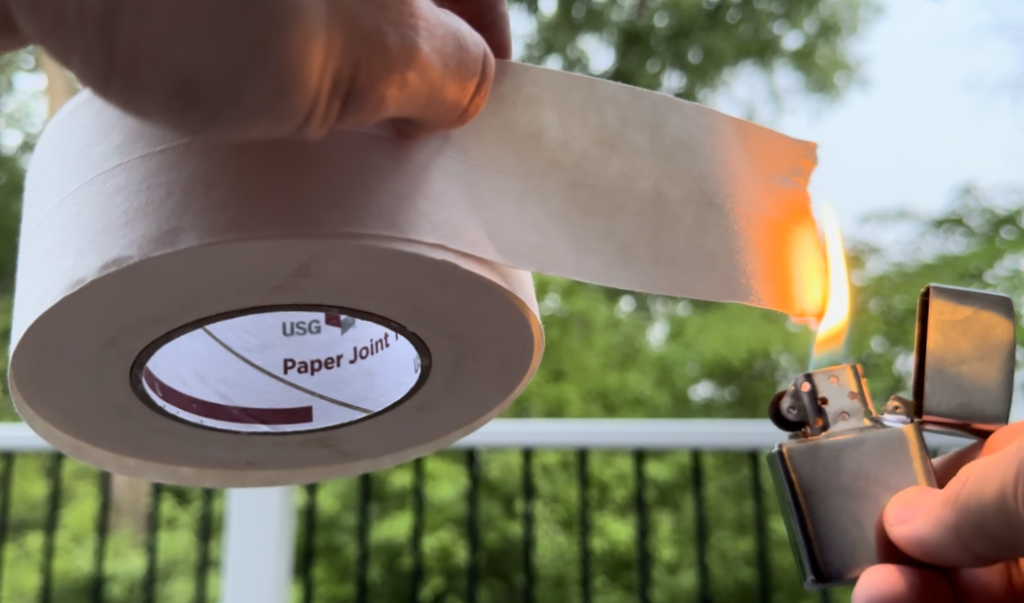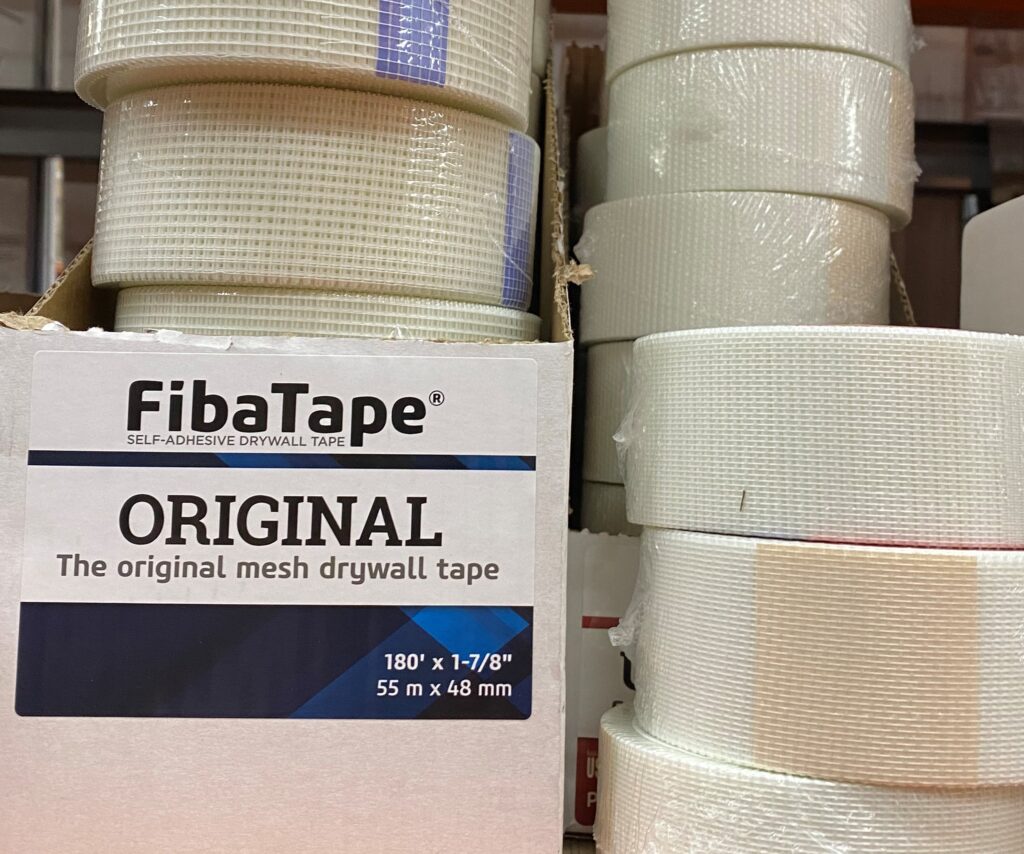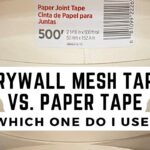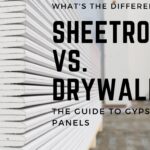The term “fire tape” is thrown around a lot. Commercial construction, residential construction, doesn’t matter.
Fire-tape is a drywall buzzword that just rolls off the tongue.
But many don’t truly understand what the term “fire tape” actually means. They assume when you add fire-tape to drywall joints, the wall becomes “fireproof.” Not the Case.
Fire tape is just one component of a fire-rated wall assembly.
Let’s get to the bottom of fire tape drywall.
What is it? Why do we need it? How to apply it? And what are the different product options for fire tape?
What is Fire Tape Drywall?
Here’s a common problem in construction – sometimes a simple question doesn’t have a simple answer.
Fire tape is simply joint compound and paper tape applied to drywall joints and corners. That’s it.

Professional tapers would say they “bed the tape in the mud” and flatten it out smooth with a taping knife.
Others might call it the “tape and bed” phase of drywall taping.
Another term for fire tape is a level 1 finish.
You see where I’m going with this. A simple process suddenly has several different nicknames in the industry, and now newcomers and onlookers are completely confused and baffled.
If there’s one thing we like to do in the construction industry – it’s create a dozen nicknames for one simple process.
So, let’s get technical for a minute – what do the manufacturers say about fire tape?
Let’s Get Technical About Fire Tape
USG, one of the biggest manufacturers of building materials, specifically drywall products, has a lot to say about fire tape.
They also know a lot about drywall mud.
USG produces both joint compound drywall mud and joint paper tape, the two components that make up the “fire tape” process.
But guess what, USG joint compound is not fire-rated on its own.
Ok, so if USG joint compound is not fire-rated, then USG paper tape must be fireproof, right? Wrong.
USG joint paper tape is just paper. Have you ever seen drywall paper tape near a flame? Instant fire.


Now for the technical part.
Both USG joint compound mud and paper joint tape meet ASTM C475, which are Standards for Joint Tape and Joint Compound.
The fire tape process is applied on drywall joints and seams. Together, the joint compound, joint paper tape, Type X drywall, and stud framing members make up a drywall assembly.
Using joint tape and joint compound mud that meets ASTM C475 is only the first step to a fire-rated wall.
Fire-rated walls are dependent on the entire assembly and all the components must be installed properly to receive the desired fire rating.
The Fire Rated Wall Assembly
Now that we know you can’t get a fire-rated wall by simply applying “fire tape” to joints, and we need to look at the entire wall assembly, we can begin to look deeper at the building design, and how to protect future occupants from fire risk.
Here are more standards you will need to understand if you want to truly understand fire-rated walls.
- ASTM E119 – Fire Resistance Standards of Wall Assemblies.
- ASTM E84 – Standard Test Methods for Surface Burning Characteristics of Building Materials.
- NFPA 5000 & NFPA 101 – Life Safety Code
- UL 263 – Fire Tests of Building Construction Material
- UL 419 – Underwriters Laboratories (UL-419) describes standards for a 1, 2, 3, and 4-hour fire-rated wall assembly.
Note: There are dozens of “ULs” for rated walls, ceilings, and floor assemblies. U419 is just one of many.
And the specific UL that applies to your project will be determined by the architect, engineer, local building codes, and use requirements of the building.
I listed UL-419 so I could tie this entire section in a bow, and show you how fire tape (remember, it’s just mud and paper tape) becomes part of the fire-rated wall assembly.
Check this out –
A 1-hour wall assembly meeting the requirements of UL-419 requires certain framing members and drywall.
The UL assembly is very specific not only on what products to use but how they should be installed.
For example, drywall can be installed horizontally or vertically, but joints must be staggered at least one stud cavity apart from joints on the opposite side of the wall.
This particular UL wall assembly is 14 pages of specific products, and how to install them.
It even describes the type of fasteners, their length, and the exact spacing for attaching drywall to the studs and track.
It’s not until page 13 that joint compound is mentioned.
Here we can finally see the fire tape requirements for a rated wall assembly.
So, what does it say?
- Apply two coats of joint compound at drywall seams and joints.
- Cover screw heads of the outer layer of drywall.
- 2-inch wide paper tape embedded in the first layer of drywall mud at all outer layers of drywall.
So now I hope you have an understanding that simply covering drywall joints with mud and tape does not “fire proof” the wall. There’s much, much more to a fire rated wall.
It’s the entire assembly, and its construction exactly to requirements, that gives a wall fire rating.
Fire tape is just one step (if done properly) of a fire-rated wall assembly.
Why Do Walls Need Fire Tape?
Fire tape is an essential fire protection measure for drywall walls and partition assemblies.
Depending on the design and use of a building, fire-resistant rated partitions are required to prevent smoke and fire from spreading through the structure.
The “fire-tape” component of a rated wall assembly is a vital part of preventing smoke and flame spread.
Why?
To prevent flame spread, fire-rated walls need to be reasonably airtight. Joint compound and paper tape over drywall seams (fire tape) prevents airflow during a fire, and hopefully contain the fire while occupants are able to exit the building.
Another requirement of a rated partition is the ability to withstand direct fire, measured in hours.
For example, a one-hour wall has one layer of 5/8″ type X drywall on each side of the wall. A two-hour rated firewall has two layers of 5/8″ type X drywall on each side of the wall.
Two-hour rated wall systems can withstand certain fire assumptions for twice as long as a one-hour wall.
Both assemblies have been through rigorous heat and fire analysis in a test furnace to be sure occupants of a building have time to escape in the event of a fire.
Not only does the “hour” rated partition provide critical time to allow people to escape a burning building, but it also contains the spread of fire and protects the structural integrity of the building while emergency fire fighting crews can arrive on the scene.
Saving not only lives but protecting property – as much as possible.
Fire tape is a vital part of firewall construction providing one, two, three, or four-hour fire resistance.
How to Apply Fire Tape on Drywall
To apply fire tape to drywall, simply spread joint compound mud over the seams and joints, and apply paper tape into the mud.
Assure the mud is completely filled under the tape to prevent air bubbles.
With a taping knife, embed the tape into the mud by dragging the knife over the tape.
Cover the flattened, embedded tape with another coat of joint compound, and smooth lightly with the taping knife.
Wipe away excess mud.
How To Use Fire Tape Mudless Drywall Joint Tape
There’s a simple solution for fire taping that’s an easy mudless application to creating firestop joints.
It’s made with high-tack adhesive, making it easy to install without requiring additional materials such as joint compound or mesh tape.

You might be wondering, why would I use joint compound and tape when I can simply apply sticky Flame Fighter tape over drywall joints and be done.
Two easy answers –
- Cost – the price of mudless adhesive fire tape is more higher. It could add significant costs, depending on the size of the projects. Estimate the cost of material before considering mudless joint tape.
- Taping is still required – you will need to use joint compound to finish the rest of the joints and screw holes anyway. Most tapers don’t want to add another step with expensive fire tape when they can stick to the tried-and-true conventional method of fire tape.
Cut the tape to length and press it into place over the joint. The high-tack adhesive will hold firmly in place and provide a fire-resistant seal.
The easy-to-use design also makes it easy to apply, as there’s no need for special taping tools and no clean-up.
E-Z tape maintains it’s strength so its easy to remove if needed, making it easy to repair any mistakes that may occur during installation.
How To Apply Drywall Fire Tape in Corners
When taping inside corners, drywall paper tape is essential for creating a smooth finish.
The drywall tape will close any gaps between the sheetrock, as required by rated firewalls.
To apply drywall tape correctly in an inside corner, start by cutting a piece of the drywall tape long enough to cover the entire length of the corner.
Leave a few inches of tape extending beyond the corner bead at either end.

The tape should be centered in the corner to cover half of each side of the drywall area.
Smooth out any air bubbles or creases, so the tape lays flat against the gypsum board.
Press down on the tape with a drywall knife to embed it into the corner bead and drywall. Apply additional coats of joint compound mud over the tape and allow it to dry.
Sanding and painting are all that remain, and just a bit of clean-up after that.
How much fun is drywall fire tape talk!
Additional Resources –
All Purpose USG Joint Compound – Home Depot
250′ Drywall Paper Joint Tape – Home Depot
E-Z Tape Mudless Flame Fighter Taping System – Home Depot



